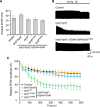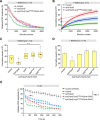Phosphorylation of Synaptojanin Differentially Regulates Endocytosis of Functionally Distinct Synaptic Vesicle Pools
- PMID: 27559170
- PMCID: PMC4995302
- DOI: 10.1523/JNEUROSCI.1470-16.2016
Phosphorylation of Synaptojanin Differentially Regulates Endocytosis of Functionally Distinct Synaptic Vesicle Pools
Abstract
The rapid replenishment of synaptic vesicles through endocytosis is crucial for sustaining synaptic transmission during intense neuronal activity. Synaptojanin (Synj), a phosphoinositide phosphatase, is known to play an important role in vesicle recycling by promoting the uncoating of clathrin following synaptic vesicle uptake. Synj has been shown to be a substrate of the minibrain (Mnb) kinase, a fly homolog of the dual-specificity tyrosine phosphorylation-regulated kinase 1A (DYRK1A); however, the functional impacts of Synj phosphorylation by Mnb are not well understood. Here we identify that Mnb phosphorylates Synj at S1029 in Drosophila We find that phosphorylation of Synj at S1029 enhances Synj phosphatase activity, alters interaction between Synj and endophilin, and promotes efficient endocytosis of the active cycling vesicle pool (also referred to as exo-endo cycling pool) at the expense of reserve pool vesicle endocytosis. Dephosphorylated Synj, on the other hand, is deficient in the endocytosis of the active recycling pool vesicles but maintains reserve pool vesicle endocytosis to restore total vesicle pool size and sustain synaptic transmission. Together, our findings reveal a novel role for Synj in modulating reserve pool vesicle endocytosis and further indicate that dynamic phosphorylation and dephosphorylation of Synj differentially maintain endocytosis of distinct functional synaptic vesicle pools.
Significance statement: Synaptic vesicle endocytosis sustains communication between neurons during a wide range of neuronal activities by recycling used vesicle membrane and protein components. Here we identify that Synaptojanin, a protein with a known role in synaptic vesicle endocytosis, is phosphorylated at S1029 in vivo by the Minibrain kinase. We further demonstrate that the phosphorylation status of Synaptojanin at S1029 differentially regulates its participation in the recycling of distinct synaptic vesicle pools. Our results reveal a new role for Synaptojanin in maintaining synaptic vesicle pool size and in reserve vesicle endocytosis. As Synaptojanin and Minibrain perturbations are associated with various neurological disorders, such as Parkinson's, autism, and Down syndrome, understanding mechanisms modulating Synaptojanin function provides valuable insights into processes affecting neuronal communication.
Keywords: endocytosis; minibrain; phosphorylation; synaptojanin.
Copyright © 2016 the authors 0270-6474/16/368882-13$15.00/0.
Figures







Similar articles
-
Activity-dependent facilitation of Synaptojanin and synaptic vesicle recycling by the Minibrain kinase.Nat Commun. 2014 Jun 30;5:4246. doi: 10.1038/ncomms5246. Nat Commun. 2014. PMID: 24977345 Free PMC article.
-
Synaptojanin is recruited by endophilin to promote synaptic vesicle uncoating.Neuron. 2003 Nov 13;40(4):733-48. doi: 10.1016/s0896-6273(03)00644-5. Neuron. 2003. PMID: 14622578
-
A slowed classical pathway rather than kiss-and-run mediates endocytosis at synapses lacking synaptojanin and endophilin.Cell. 2005 Nov 4;123(3):521-33. doi: 10.1016/j.cell.2005.09.026. Cell. 2005. PMID: 16269341
-
Endophilin and synaptojanin hook up to promote synaptic vesicle endocytosis.Neuron. 2003 Nov 13;40(4):665-7. doi: 10.1016/s0896-6273(03)00726-8. Neuron. 2003. PMID: 14622570 Review.
-
Exocytosis and endocytosis of synaptic vesicles and functional roles of vesicle pools: lessons from the Drosophila neuromuscular junction.Neuroscientist. 2005 Apr;11(2):138-47. doi: 10.1177/1073858404271679. Neuroscientist. 2005. PMID: 15746382 Review.
Cited by
-
Parkinson's disease: convergence on synaptic homeostasis.EMBO J. 2018 Sep 14;37(18):e98960. doi: 10.15252/embj.201898960. Epub 2018 Jul 31. EMBO J. 2018. PMID: 30065071 Free PMC article. Review.
-
The Role of Rab Proteins in Parkinson's Disease Synaptopathy.Biomedicines. 2022 Aug 10;10(8):1941. doi: 10.3390/biomedicines10081941. Biomedicines. 2022. PMID: 36009486 Free PMC article. Review.
-
Comprehensive transcriptome and scRNA-seq analyses uncover the expression and underlying mechanism of SYNJ2 in papillary thyroid carcinoma.IET Syst Biol. 2024 Oct;18(5):183-198. doi: 10.1049/syb2.12099. Epub 2024 Oct 6. IET Syst Biol. 2024. PMID: 39370684 Free PMC article.
-
The membrane strikes back: phosphoinositide binding regulates Skywalker function.Nat Struct Mol Biol. 2016 Nov 4;23(11):956-957. doi: 10.1038/nsmb.3313. Nat Struct Mol Biol. 2016. PMID: 27814349 No abstract available.
-
Synaptic, Mitochondrial, and Lysosomal Dysfunction in Parkinson's Disease.Trends Neurosci. 2019 Feb;42(2):140-149. doi: 10.1016/j.tins.2018.11.001. Epub 2018 Nov 30. Trends Neurosci. 2019. PMID: 30509690 Free PMC article. Review.
References
Publication types
MeSH terms
Substances
Grants and funding
LinkOut - more resources
Full Text Sources
Other Literature Sources
Molecular Biology Databases
Research Materials
